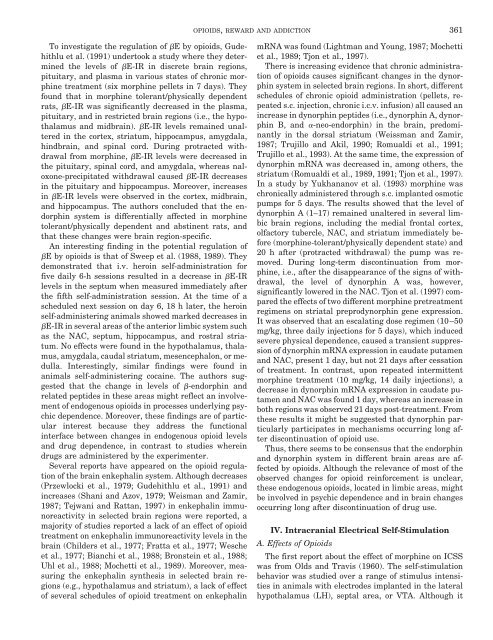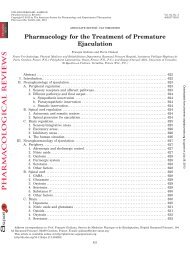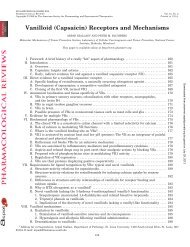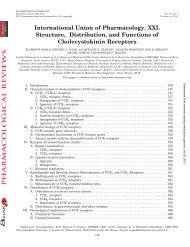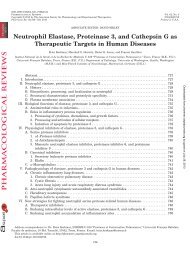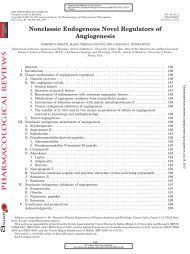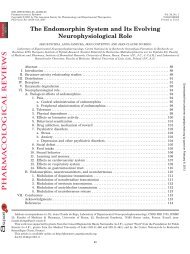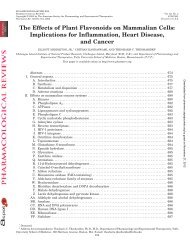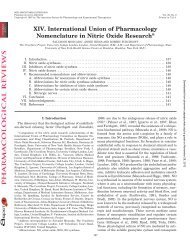Opioids, Reward and Addiction: An Encounter of Biology ...
Opioids, Reward and Addiction: An Encounter of Biology ...
Opioids, Reward and Addiction: An Encounter of Biology ...
Create successful ePaper yourself
Turn your PDF publications into a flip-book with our unique Google optimized e-Paper software.
To investigate the regulation <strong>of</strong> E by opioids, Gudehithlu<br />
et al. (1991) undertook a study where they determined<br />
the levels <strong>of</strong> E-IR in discrete brain regions,<br />
pituitary, <strong>and</strong> plasma in various states <strong>of</strong> chronic morphine<br />
treatment (six morphine pellets in 7 days). They<br />
found that in morphine tolerant/physically dependent<br />
rats, E-IR was significantly decreased in the plasma,<br />
pituitary, <strong>and</strong> in restricted brain regions (i.e., the hypothalamus<br />
<strong>and</strong> midbrain). E-IR levels remained unaltered<br />
in the cortex, striatum, hippocampus, amygdala,<br />
hindbrain, <strong>and</strong> spinal cord. During protracted withdrawal<br />
from morphine, E-IR levels were decreased in<br />
the pituitary, spinal cord, <strong>and</strong> amygdala, whereas naloxone-precipitated<br />
withdrawal caused E-IR decreases<br />
in the pituitary <strong>and</strong> hippocampus. Moreover, increases<br />
in E-IR levels were observed in the cortex, midbrain,<br />
<strong>and</strong> hippocampus. The authors concluded that the endorphin<br />
system is differentially affected in morphine<br />
tolerant/physically dependent <strong>and</strong> abstinent rats, <strong>and</strong><br />
that these changes were brain region-specific.<br />
<strong>An</strong> interesting finding in the potential regulation <strong>of</strong><br />
E by opioids is that <strong>of</strong> Sweep et al. (1988, 1989). They<br />
demonstrated that i.v. heroin self-administration for<br />
five daily 6-h sessions resulted in a decrease in E-IR<br />
levels in the septum when measured immediately after<br />
the fifth self-administration session. At the time <strong>of</strong> a<br />
scheduled next session on day 6, 18 h later, the heroin<br />
self-administering animals showed marked decreases in<br />
E-IR in several areas <strong>of</strong> the anterior limbic system such<br />
as the NAC, septum, hippocampus, <strong>and</strong> rostral striatum.<br />
No effects were found in the hypothalamus, thalamus,<br />
amygdala, caudal striatum, mesencephalon, or medulla.<br />
Interestingly, similar findings were found in<br />
animals self-administering cocaine. The authors suggested<br />
that the change in levels <strong>of</strong> -endorphin <strong>and</strong><br />
related peptides in these areas might reflect an involvement<br />
<strong>of</strong> endogenous opioids in processes underlying psychic<br />
dependence. Moreover, these findings are <strong>of</strong> particular<br />
interest because they address the functional<br />
interface between changes in endogenous opioid levels<br />
<strong>and</strong> drug dependence, in contrast to studies wherein<br />
drugs are administered by the experimenter.<br />
Several reports have appeared on the opioid regulation<br />
<strong>of</strong> the brain enkephalin system. Although decreases<br />
(Przewlocki et al., 1979; Gudehithlu et al., 1991) <strong>and</strong><br />
increases (Shani <strong>and</strong> Azov, 1979; Weisman <strong>and</strong> Zamir,<br />
1987; Tejwani <strong>and</strong> Rattan, 1997) in enkephalin immunoreactivity<br />
in selected brain regions were reported, a<br />
majority <strong>of</strong> studies reported a lack <strong>of</strong> an effect <strong>of</strong> opioid<br />
treatment on enkephalin immunoreactivity levels in the<br />
brain (Childers et al., 1977; Fratta et al., 1977; Wesche<br />
et al., 1977; Bianchi et al., 1988; Bronstein et al., 1988;<br />
Uhl et al., 1988; Mochetti et al., 1989). Moreover, measuring<br />
the enkephalin synthesis in selected brain regions<br />
(e.g., hypothalamus <strong>and</strong> striatum), a lack <strong>of</strong> effect<br />
<strong>of</strong> several schedules <strong>of</strong> opioid treatment on enkephalin<br />
OPIOIDS, REWARD AND ADDICTION 361<br />
mRNA was found (Lightman <strong>and</strong> Young, 1987; Mochetti<br />
et al., 1989; Tjon et al., 1997).<br />
There is increasing evidence that chronic administration<br />
<strong>of</strong> opioids causes significant changes in the dynorphin<br />
system in selected brain regions. In short, different<br />
schedules <strong>of</strong> chronic opioid administration (pellets, repeated<br />
s.c. injection, chronic i.c.v. infusion) all caused an<br />
increase in dynorphin peptides (i.e., dynorphin A, dynorphin<br />
B, <strong>and</strong> -neo-endorphin) in the brain, predominantly<br />
in the dorsal striatum (Weissman <strong>and</strong> Zamir,<br />
1987; Trujillo <strong>and</strong> Akil, 1990; Romualdi et al., 1991;<br />
Trujillo et al., 1993). At the same time, the expression <strong>of</strong><br />
dynorphin mRNA was decreased in, among others, the<br />
striatum (Romualdi et al., 1989, 1991; Tjon et al., 1997).<br />
In a study by Yukhananov et al. (1993) morphine was<br />
chronically administered through s.c. implanted osmotic<br />
pumps for 5 days. The results showed that the level <strong>of</strong><br />
dynorphin A (1–17) remained unaltered in several limbic<br />
brain regions, including the medial frontal cortex,<br />
olfactory tubercle, NAC, <strong>and</strong> striatum immediately before<br />
(morphine-tolerant/physically dependent state) <strong>and</strong><br />
20 h after (protracted withdrawal) the pump was removed.<br />
During long-term discontinuation from morphine,<br />
i.e., after the disappearance <strong>of</strong> the signs <strong>of</strong> withdrawal,<br />
the level <strong>of</strong> dynorphin A was, however,<br />
significantly lowered in the NAC. Tjon et al. (1997) compared<br />
the effects <strong>of</strong> two different morphine pretreatment<br />
regimens on striatal preprodynorphin gene expression.<br />
It was observed that an escalating dose regimen (10–50<br />
mg/kg, three daily injections for 5 days), which induced<br />
severe physical dependence, caused a transient suppression<br />
<strong>of</strong> dynorphin mRNA expression in caudate putamen<br />
<strong>and</strong> NAC, present 1 day, but not 21 days after cessation<br />
<strong>of</strong> treatment. In contrast, upon repeated intermittent<br />
morphine treatment (10 mg/kg, 14 daily injections), a<br />
decrease in dynorphin mRNA expression in caudate putamen<br />
<strong>and</strong> NAC was found 1 day, whereas an increase in<br />
both regions was observed 21 days post-treatment. From<br />
these results it might be suggested that dynorphin particularly<br />
participates in mechanisms occurring long after<br />
discontinuation <strong>of</strong> opioid use.<br />
Thus, there seems to be consensus that the endorphin<br />
<strong>and</strong> dynorphin system in different brain areas are affected<br />
by opioids. Although the relevance <strong>of</strong> most <strong>of</strong> the<br />
observed changes for opioid reinforcement is unclear,<br />
these endogenous opioids, located in limbic areas, might<br />
be involved in psychic dependence <strong>and</strong> in brain changes<br />
occurring long after discontinuation <strong>of</strong> drug use.<br />
IV. Intracranial Electrical Self-Stimulation<br />
A. Effects <strong>of</strong> <strong>Opioids</strong><br />
The first report about the effect <strong>of</strong> morphine on ICSS<br />
was from Olds <strong>and</strong> Travis (1960). The self-stimulation<br />
behavior was studied over a range <strong>of</strong> stimulus intensities<br />
in animals with electrodes implanted in the lateral<br />
hypothalamus (LH), septal area, or VTA. Although it


